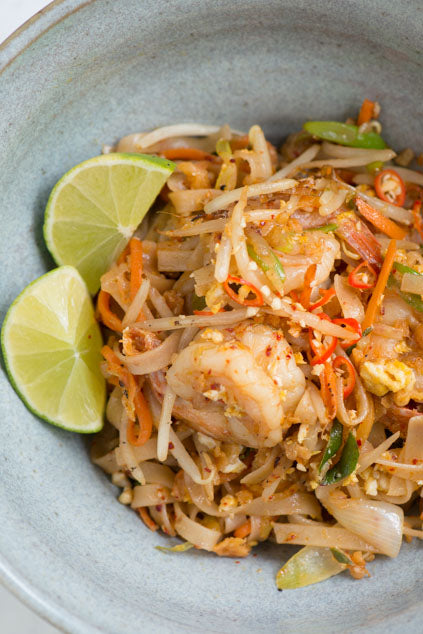
Our Perfect Pad Thai Recipe
-
10 minutes prep time
-
15 minutes cook time
-
Easy

The art of Pad Thai (or phat thai as a more accurate transliteration of the Thai name) - and much of Southeast Asian cooking - is to balance the sweet, sour, salt and umami flavours.
What is Pad Thai made from?
In any Pad Thai recipe, palm sugar is the sweet element, the tamarind water is sour element, and fish sauce brings salt and umami. Chopped pickled turnip would always be used in Thailand, and brings an extra sweet-sour tang.
Why does tamarind go in a Pad Thai?
Tamarind adds the crucial sour balance to a traditional Pad Thai. Make your own tamarind water from tamarind pulp (see recipe in article What Is Tamarind Water?). Many prefer using tamarind water, believing the taste is a little fresher than that of tamarind puree – and you will have the same concentration as we used in the recipe. Similarly if using a different brand of fish sauce, adjust the quantity as the salt levels may be different. Chicken can be replaced with large king prawns (see images at the start of the post) or firm tofu.
Remember to soak the Thai rice stick noodles in cold water well before cooking. You can speed up the process by soaking them in warm water for 20 minutes. But don't be tempted to cut the time down to a few minutes by pouring over boiling water - the noodles will clump together in the pan.
Is Pad Thai meant to be spicy?
A Pad Thai shouldn't be overly hot as diners will adjust flavours at the table to suit their taste. Any chilli powder can be used in the recipe, we've used Korean gochugaru here as I think the citrus heat works well, and add according to taste.
This is the perfect prawn Pad Thai recipe - prepare your veg, noodles and pickled turnip for a 10 minute supper
Find more Southeast Asian recipes here, or browse all the Southeast Asian ingredients available at Sous Chef.
Ingredients for Pad Thai Serves: 2
- 3 tbsp vegetable oil
- 1 shallot, finely sliced
- 2 cloves garlic, minced
- 200g chicken, sliced into thin strips or 175g shelled king prawns
- 4 tbsp fish sauce
- 3 tbsp tamarind water (see how to make tamarind water) made using tamarind pulp
- 25g palm sugar
- 110g 5mm Thai rice stick noodles, soaked in cold water for 1 hour and drained
- 1 carrot, cut into fine 'julienne' strips
- 100g bean sprouts
- 3 spring onions, finely sliced on the diagonal
- 15g chopped pickled turnip
- 1/2 tsp chilli powder
- 1 egg
- 20g unsalted peanuts, ground or crushed
- 1/2 lime
To garnish at the table
- Chopped chilli, lime quarters, fish sauce, caster sugar
Method for Pad Thai
- Measure out the ingredients, and lay them out in the order they will be added to the pan (as above).
- Heat the wok over high heat, and pour in the vegetable oil. Fry the shallot for 1 minute, before adding the garlic. As the shallot starts to brown at the edges, add the chicken or prawns. Move the ingredients around the pan so the chicken or prawns cook evenly.
- When the chicken starts to look cooked on all sides (or the prawns are changing colour) pour in the fish sauce, tamarind water and palm sugar. Stir well to help the palm sugar dissolve. Leave the sauce to simmer for 2 minutes until it turns a darker colour, as the sugar starts to caramelise.
- Add the noodles, and carrot into the pan and move around vigorously to help. When the noodles soften add the bean sprouts, spring onion, pickled turnip, and chilli powder. Cook for a further 2 minutes.
- Move the noodles and vegetables to one side of the pan, making a space in the middle of the pan. Crack the egg into the space, and mix gently to break up the yolk. Cook the egg through, breaking it up and turning it as if you are making scrambled egg. When the egg is set, toss together with the noodle vegetable mixture. Stir in the peanuts and juice of half a lime.
- Serve garnished with the chilli slices, lime quarters, fish sauce and sugar - so diners can adjust the flavours to suit their taste.



